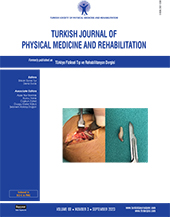Developing a common metric using current scales for assessing functioning in patients with knee osteoarthritis
2 Department of Physical Medicine and Rehabilitation, Ankara University Faculty of Medicine, Ankara, Türkiye
3 Department of Biostatistics, Ankara University Faculty of Medicine, Ankara, Türkiye DOI : 10.5606/tftrd.2023.12387 Objectives: Various scales exist to assess different domains of functioning in knee osteoarthritis (OA). This study aimed to explore whether it is possible to develop a common metric (CM) from the frequently used scales to assess functioning in knee OA.
Patients and methods: The methodological study evaluated 411 patients (81 males, 330 females; mean age: 61.8±10.5 years; range, 41 to 88 years) with knee OA. Data from the Health Assessment Questionnaire, Oxford Knee Score, Medical Outcomes Study Short Form 36, Knee Injury and Osteoarthritis Outcome Score, Western Ontario and McMaster Universities Arthritis Index, and the Nottingham Health Profile were used, and the items focusing on self-care, mobility, and domestic activity domains based on the activities and participation component of the International Classification of Functioning, Disability, and Health were included. Concurrent calibration was performed to combine the items of the scales. The CM parameters were estimated using the Rasch measurement model. Reliability was assessed using the person separation index. The CM was utilized to generate a transformation table to convert the scale scores to each other based on the reference metric score.
Results: Each scale fitted the Rasch model. Item invariance was achieved for the CM (p=0.775). The CM had a person separation index of 0.827. Age, sex, and disease duration did not cause difference in item functions. The CM satisfied the assumptions of unidimensionality and local independence.
Conclusion: A reliable CM was created from the commonly used scales to measure functioning in individuals with knee OA. Thus, clinicians and researchers can refer to the transformation table to directly compare scores of those scales and use them interchangeably.
Keywords : Common metric, concurrent calibration, functioning, knee osteoarthritis, Rasch model
















